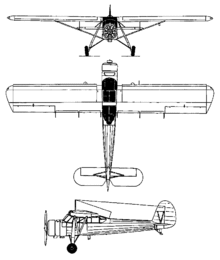Kokusai Ki-76
| Ki-76 | |
|---|---|

| |
| Role | Liaison/observation |
| Manufacturer | Kokusai |
| First flight | 1941 |
| Introduction | 1942 |
| Retired | 1945 |
| Primary user | Imperial Japanese Army Air Service |
| Number built | 937 including a single prototype |
The Kokusai Ki-76, or Liaison Aircraft Type 3 (in Japanese: 三式指揮連絡機), was a Japanese high-wing monoplane artillery spotter and liaison aircraft that served in World War II. The Allied reporting name was "Stella".
Design and development[edit]
In 1940, the Imperial Japanese Army Air Force ordered the Nippon Kokusai Koku Kogyo to produce an artillery spotting and liaison aircraft. The resulting Ki-76 was inspired by, and similar to, the German Fieseler Fi 156 "Storch", although not a direct copy.[1] Like the Storch, it was a high-winged monoplane with a fixed tailwheel undercarriage. However, rather than the slotted flaps used by the German aircraft, the Ki-76 used Fowler flaps, while it was powered by Hitachi Ha-42 radial engine rather than the Argus As 10 inline engine of the Storch.
First flying in May 1941, the Ki-76 proved successful when evaluated against an example of the Fi-156, and was ordered into production as the Army Type 3 Command Liaison Plane in November 1942.[2]
Operational history[edit]

The Ki-76 remained in service as an artillery spotter and liaison aircraft until the end of the war. Ki-76s were also used as anti-submarine aircraft, operating from the Japanese Army's escort carrier, the Akitsu Maru, being fitted with an arrestor hook and carrying two 60 kg (132 lb) depth charges.[3]
Operators[edit]
Specifications (Ki-76)[edit]

Data from Encyclopedia of Military Aircraft,[4] Japanese Aircraft of the Pacific War[5]
General characteristics
- Crew: 2
- Length: 9.65 m (31 ft 8 in)
- Wingspan: 15 m (49 ft 3 in)
- Height: 2.9 m (9 ft 6 in)
- Wing area: 29.4 m2 (316 sq ft)
- Empty weight: 1,110 kg (2,447 lb)
- Gross weight: 1,530 kg (3,373 lb)
- Max takeoff weight: 1,623 kg (3,578 lb)
- Powerplant: 1 × Hitachi Ha42 9-cylinder air-cooled radial piston engine, 231 kW (310 hp)
- Propellers: 2-bladed fixed-pitch propeller
Performance
- Maximum speed: 178 km/h (111 mph, 96 kn) at sea level
- Range: 750 km (470 mi, 400 nmi)
- Service ceiling: 5,630 m (18,470 ft)
Armament
- Guns: 1× 7.7 mm (0.303 in) machine gun in rear cockpit
- Bombs: 2× 60 kg (132 lb) depth charges (some variants)
See also[edit]
Aircraft of comparable role, configuration, and era
- Fieseler Fi 156 Storch
- IMAM Ro.63
- Kobeseiko Te-Gō
- Repülőgépgyár Levente II
- Westland Lysander
- Taylorcraft Auster
Related lists
References[edit]
- ^ Francillon 1979, p. 147.
- ^ Francillon 1979, p. 148.
- ^ Francillon 1979, pp. 148–149.
- ^ Jackson 2002, p. 224
- ^ Francillon 1979, p. 149
Sources[edit]
- Francillon, René J. (1979). Japanese aircraft of the Pacific War. London: Putnam. ISBN 0-370-30251-6. OCLC 6124909. (new edition 1987 by Putnam Aeronautical Books, ISBN 0-85177-801-1.)
- Jackson, Robert (2002). The Encyclopedia of Military Aircraft. Parragon. ISBN 0-7525-8130-9..
